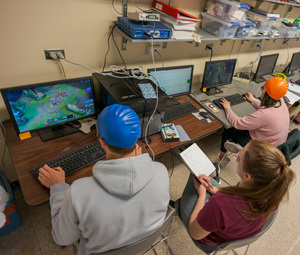Students study video gamers brain waves, fruit fly concussions

CHADRON – The pursuit of scientific knowledge can lead researchers to try measuring things that seem a bit far fetched, like brain changes in people playing an online game, or the effect of concussions on fruit flies.
But creating experiments involving those measurements was an important part of what several Chadron State College students learned from independent research projects they completed last semester, and the implications of their work generated interest from other young scientists at the annual Nebraska Academy of Sciences conference in Lincoln last April.
An audience of about 20 people showed up to hear the presentation that Gabrielle Brumfield and Brittany Soukup made at the conference about research they and Greggory Peterson conducted on the brains of people learning to play the online game League of Legends, according to Dr. Johnica Morrow, CSC assistant science professor and adviser for the project. That might be because League of Legends is played worldwide and has its own professional league with sponsored teams and multi-million dollar tournaments, said Morrow.
“The pro gaming circuit people would be interested in things that enhance performance, just like you would see in any type of sports,” she said.
The research paper that students Shyanna Neu and Kinsley Mason presented on the effect of concussions on fruit flies with a particular genetic makeup also attracted interest at the conference, and could be relevant to sports, where the long term effects of concussions on brain function has become a topic of concern, according to Dr. Ann Buchmann, the CSC science professor who advised that project.
Humans have the same version of the genetic material as the fruit flies that the students studied and scientists would like to know if that genetic factor could be associated with worse concussions, said Buchmann.
“It might be important to have genetic testing done on athletes or others who have suffered from multiple concussions,” she said. “It might change the way that certain sports are played or the way the military treats personnel that have been exposed to head trauma.”
Just setting up and conducting the research was a challenging part of the students’ projects. For their research Neu and Mason had to create a device that could deliver a precise amount of force to the head of a fruit fly, without killing it, said Buchmann. They used an aquarium flow regulator and a laboratory air pump to propel a tiny sponge at a fly that was sedated in the tip of a plastic pipet, she said, but then had to experiment to determine the amount of force needed.
“The first time they tried it the fruit fly was propelled across the room,” she said. “After that they calibrated the air flow so the hit was more subtle.”
Determining the effect of the blow on the fly was the next step, and involved putting the concussed flies, and a control group that was not hit on the head, into a long tube and observing them climb up its sides, which is a normal fruit fly behavior.
“They discovered that most of the concussed flies had difficulty reaching the top of the tube, while the control flies did not,” Buchmann said.
For the gaming research, Brumfield, Soukup and Peterson had to find representative subjects who had video game experience, but hadn’t played League of Legends, said Morrow.
“It was valuable to go through the process of ‘How do I design this survey that is going to exclude the kind of things that will complicate our study,’” she said.
The students also had to determine which brain waves to measure and how to correlate game activity with the measurements, a problem they solved by taking notes of what was happening on the screen as the electrodes attached to the subjects’ heads registered spikes in brain activity.
“They spent a lot of time deciding how to collect data in the best possible way,” Morrow said. “The students got a lot out of that process and essentially developing the project themselves.”
Watching subjects’ brain waves change with the play of the game was fascinating, the students said.
“There was always a huge fluctuation when their avatar (game character) died or whenever they became extremely frustrated,” Soukup said.
Brumfield agreed.
“Seeing spikes in (brain wave) activity when a player died, cursed or fought enemies was really interesting to me,” Brumfield said.
Preliminary results from the gaming project showed promise, but more work would be needed to reach definite conclusions, according to Morrow.
“What we were seeing was that some of the brain wave patterns differed while watching a video about the game, playing a tutorial and actually playing the game,” Morrow said. “We would predict that different patterns of brain waves develop as people became more proficient.”
Additional research would also be needed to draw firm answers from the fruit fly experiments, but preliminary results indicate that a specific genetic variation may make flies more susceptible to brain damage from concussions, said Buchmann. Another part of the project suggests that multiple low level concussions may be worse than one larger blow.
Both studies could be topics for future research at CSC.
“I would love to expand to different types of video games and see the difference in effects on the brain,” agreed Soukup.
Even though the students only scratched the surface of potential work on their topics, they gained a lot from the projects, Buchmann said.
“They learned to make good observations and troubleshoot problems,” Buchmann said. “They also learned how to build off the scientific literature, determining what others have done and what gaps there are in our scientific understanding.”
Category: Campus News, Physical and Life Sciences

